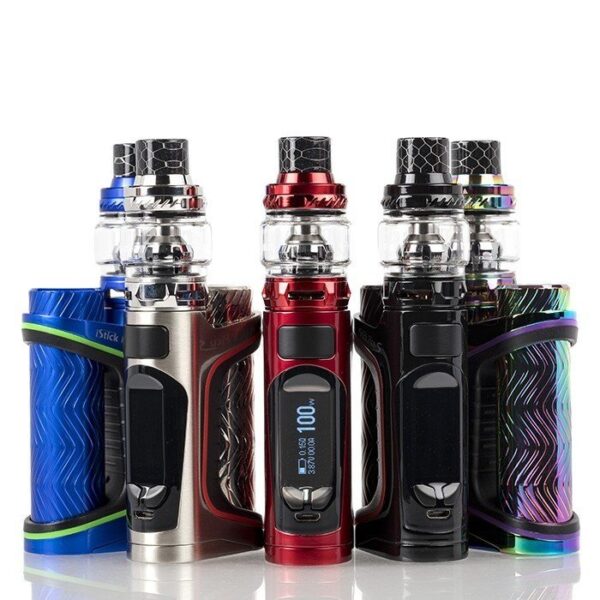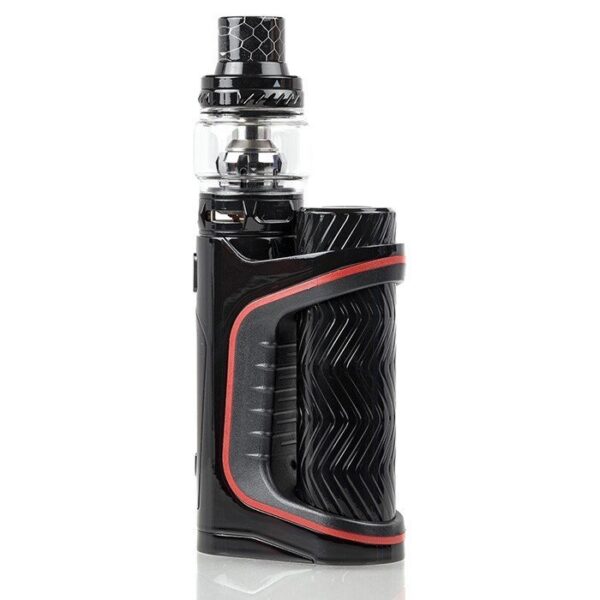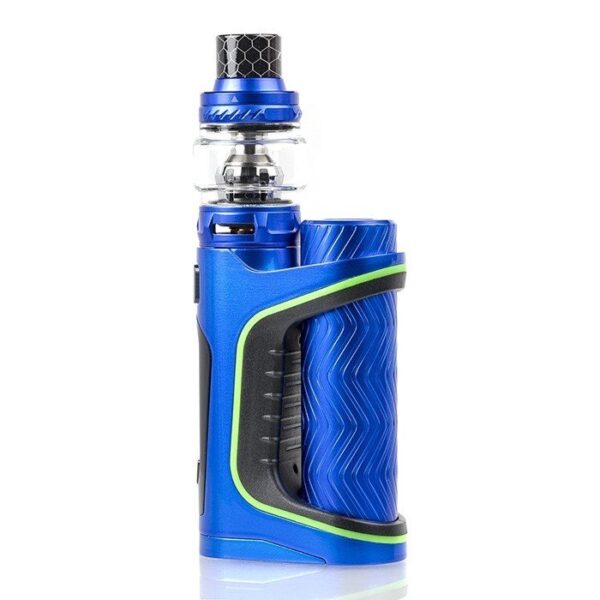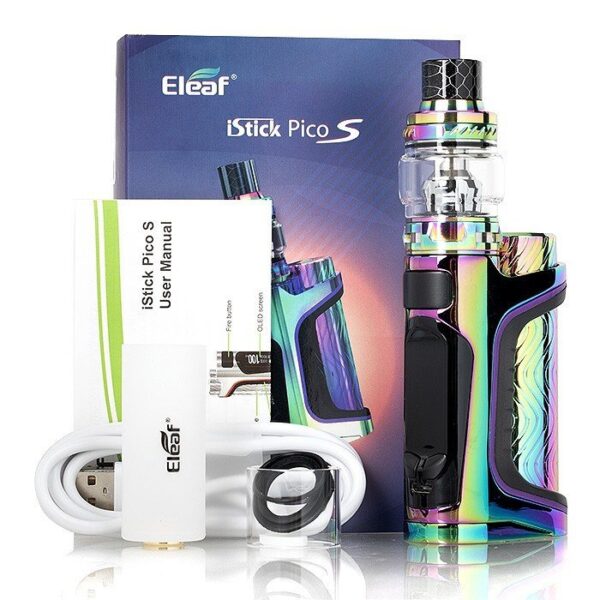Table of Contents
Last Updated on July 18, 2018 by Team Spinfuel
The iStick Pico S Kit
I could swear I just wrote a Pico review… oh wait, I did! And in it, I said that Eleaf should strongly consider bringing an end to the Pico line. Not because they’re bad, but because Eleaf just created its two finest renditions of the series yet – the diminutive Pico Resin (reviewed here), and this gem – the 21700-powered iStick Pico S. And I’m not sure it’s going to get better than this.


For starters, the Pico S just looks like something entirely different. My chrome and black test model (with red accents) is both simple and sharply designed, with some simple grooved engraving, slick machining, and – gasp – subtle LED lights I actually don’t mind at all.
The mod itself is basically a two-piece design. Rather than using the usual Pico top-loading battery chamber, the entire battery chamber comes off to load the cell, then screws snugly back into place in the slot. (It’s easier to show than describe.) I wasn’t sure how durable this design would be, considering there isn’t clearly defined threads for the sleeve, but the Pico S turned out to be rock solid when using and abusing it in the wild.
The rest of the 100-watt Pico S is equally sharp, with smooth machining and error-free ergonomics. 25-26mm atomizers fit comfortably on the 510 connection, but be wary of where the airflow slots line up, since the battery sleeve could potentially block smooth airflow. I didn’t have any issues with this, but it’s worth mentioning for those using older, single airflow slot tanks.
That said, the Pico S 510 accepted every tank and RDA with ease, and no gaps or significant overhang. Plus, it comes with its own companion atomizer, the ELLO Vate sub-ohm tank, right in the box. But we’ll get to that in a few paragraphs.
The monochrome OLED display is standard fare, but it’s clear and stays out of the way. While I’m a little tired of this ancient setup, I mind it a little less here, since the almost mechanical design begs for something old-school. And since Eleaf practically invented this linear menu structure, they get points for keeping it simple here.
Don’t get me wrong – this is the same company that made the gorgeous Tessera display, and I’d love to see some more innovation here. But as what I believe should be the final round of Pico devices, Eleaf gets a pass for standing pat with the screen.
All in all, the Pico S might arguably be the best-looking one in the series. And it MIGHT be the best performing, depending on how you’re using it.
Feature Highlights
In terms of “highlights,” the Pico S has two key selling points. First, the 21700-battery capability, which works pretty well, even if the larger cells don’t really provide too much of a duration boost. Without the extra battery power, the Pico S probably wouldn’t be able to hit 100 watts with such ease, but at the same time, I’m about ready to bail on the 2×700 fad entirely. My old 26650 cells offered legitimate boosts in power and duration – when are the 2×700 cells going to do the same?
For the record, the Pico S works fine in 18650 mode (with included adapter) but there’s a slight dip in power performance, and the longevity is just passable. No matter which battery format you choose, have spares ready if you’re taking the Pico out for the night.
The other highlight is the ELLO Vate tank, which doesn’t offer much to owners of today’s leading 24-26mm sub-ohm atomizers, but is certainly a much nicer throw-in than most. Where the Pico Resin’s limp MELO 4 tank barely qualified for inclusion in the box, the 6.5mL capacity ELLO Vate is a much better “me too” tank than I ever expected it to be.
Using the proprietary HW-class coils, the Pico S offers smooth, flavorful performance that’s on par with most of today’s popular devices. Both the standard HW-M and the mesh HW-N break in quickly, have relatively high wattage limits, and can easily fill your room with vapor. Unfortunately, like the Pico Resin’s companion tank, these coils also wear down far too easily… with barely enough time to realize it’s happening before they’re completely flat and flavorless.
Like I say all too often – enjoy the ELLO Vate as part of the kit, but don’t go out of your way to buy it alone. I enjoyed the performance while it lasted, but these moments were far too fleeting to recommend it.
Eleaf iStick Pico S Kit Specs:
- Maximum wattage: 100W
- Temperature range: 200 – 600F / 100 – 315C
- Resistance range: 0.05 – 3.0 ohm
- Voltage range: 0.5 – 9V
- Output modes: VW / Ni / Ti /SS / M1 / M2 / M3 / Bypass
- Compatible with 21700 or 18650 battery
- Enlarged OLED display
- Oversized firing button with adjustment buttons on face
- Rapid firing speed of 0.025 seconds
- Customizable 7-color LED lights
- 2A Micro-USB charging / upgrade port
- Spring-loaded 510 connection
- Powered by single 21700 or 18650 battery
- Size: 52.5mm x 28.5mm x 81mm
Eleaf ELLO VATE Sub-Ohm Tank Features:
- 28mm Diameter
- 5mL Juice Capacity
- Superior Stainless Steel Construction
- Pyrex Convex Glass Reinforcement
- Eleaf’s HW Series Coils
- 2ohm HW-N Net Coils Coil – rated for 40-80W
- 15ohm HW-M Multi-Hole Coil – rated for 50-100W
- Dual Adjustable Airflow at Base
- Convenient Retractable Top-Fill Method
- 810 Resin Widebore Drip TIp
- Detachable Structure
- 510 Connection
Eleaf iStick Pico S Kit Contents:
- 1x iStick Pico S Box Mod (No Cell)
- 1x ELLO VATE Atomizer 6.5ml
- 1x HW-N 0.2ohm Head
- 1x HW-M 0.15ohm Head
- 1x QC USB Cable
Observations
Despite the odd duck tank, the Pico S is a really strong vape, easily hitting its 100-watt/600-degree mark without flinching. And for the most part, it stepped its way up the ladder without any problems, though there was a slight pulsing that occurred above 85 watts – nothing that gets in the way of the experience, but a little surprising considering the pedigree of this series.
The temp control mode is fairly straightforward, allowing for a full slate of wire types, three TCR slots, and all the other industry standards. I spent a limited amount of time here, since the performance was solid, if not spectacular, and didn’t seem to offer much benefit over the stock wattage mode. As always, nickel coils seemed to provide the most headache, but TCR (as always) set things straight, allowing for a comfortable, enjoyable vape.
The one mode that DIDN’T work for me was bypass mode – arguably the easiest mode for a device to have, since it’s basically unregulated power. However, the Pico S repeatedly balked when trying to run it this way, so if bypass is important, be sure to test the device before buying. That said, by a show of hands, how many of you are considering a Pico S for its bypass capabilities?
(Yeah, I thought so…)
Another observation worth mentioning is the battery tube. It doesn’t mention anything in the documentation, but without pushing down on the tube when attaching a battery, the threads won’t catch, and the spring-loaded connection won’t engage. You might laugh, but I found myself twirling the tube for nearly a minute before realizing I needed to add some force to the proceedings.
Once in place, the tube works fine and stays put, even under heavy use. But the threads are thin, and there’s noticeable creaking with trying to tighten the connection, making me wonder about long-term durability. If there’s a significant drop in performance, I’ll be sure to update this review.
Verdict
Nitpicking aside, I still enjoyed using the Pico S, and plan to keep it in my rotation long after this gets published. The unique design, rock solid construction and strong vape quality far outweighed my concerns about the coils, metal sleeve and battery life. Despite seeing so many Pico devices over the last few years, the Pico S (along with the Pico Resin) represents the pinnacle of the series, and a good jumping off point for Eleaf’s next adventures.














